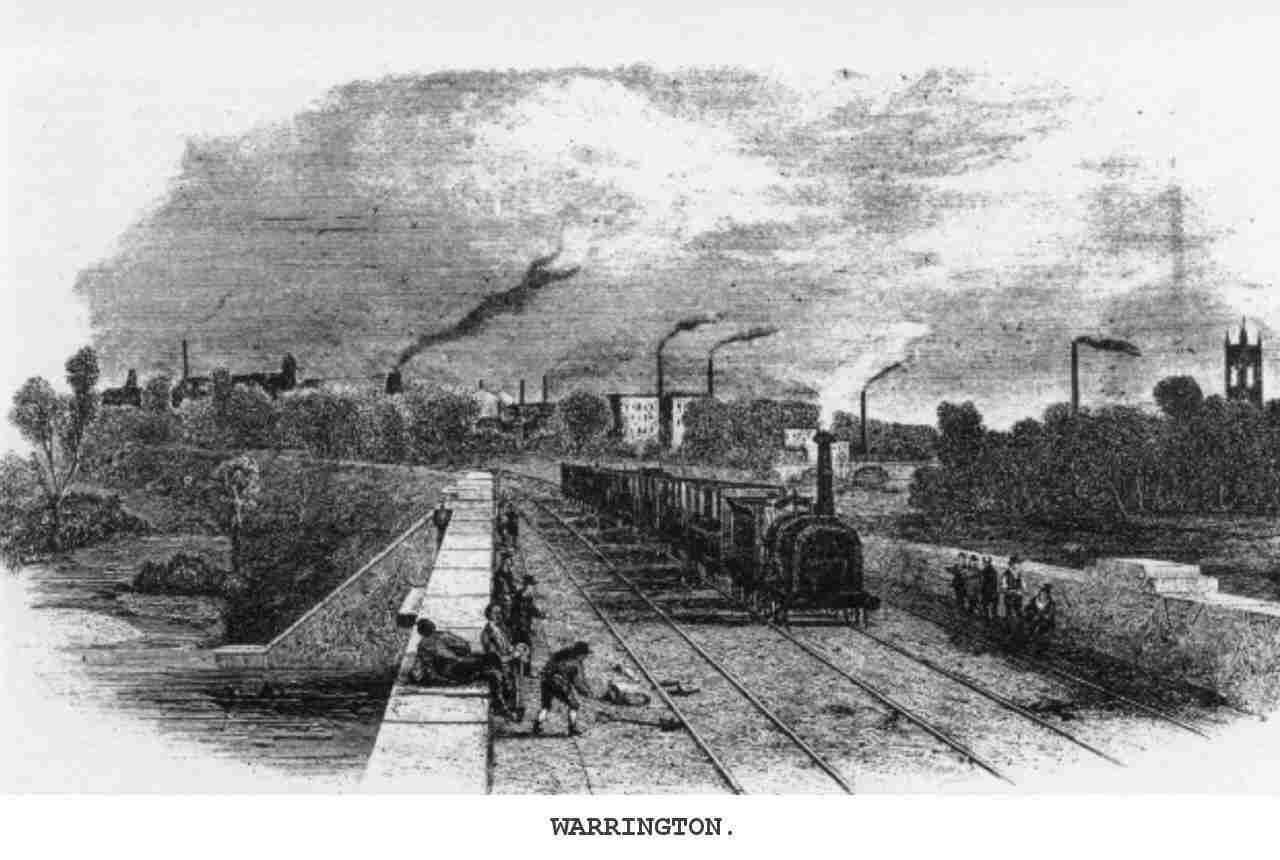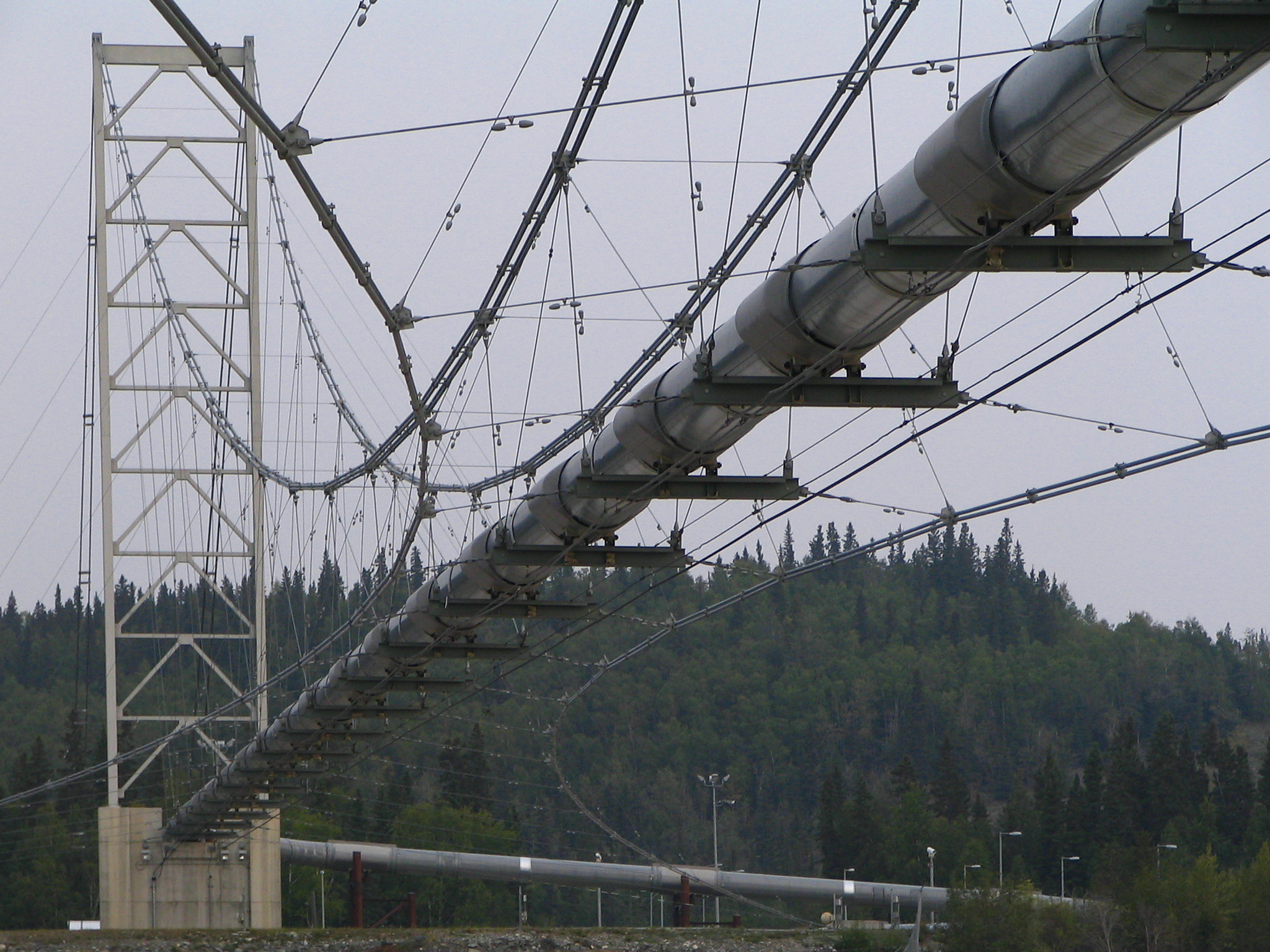|
Messrs. Crosfield’s Transporter Bridge
Messrs. Crosfield’s Transporter Bridge was a transporter bridge in Warrington, England, United Kingdom at , which was built by Mr. James Newall for the factory Messrs. Joseph Crosfield and Son in 1905 for the realisation of an interconnection of a new part of the factory south of Mersey river with the existing factory part north of Mersey river in 1905. As there was vessel traffic with tall ships on Mersey river at those days, a transporter bridge with a clearance of 22.86 metres (75 ft) was chosen for the realization of the desired crossing. The transporter bridge was realized as suspension bridge with wind guy cables, which were fixed on crossbars at the support towers. While the tower on the south site was completely free-standing, that on the north bank was erected on the roof of a warehouse building of the factory. The bridge had a span width of 76.2 metres (250 ft) and a gondola capable of transporting a load of 2.5 tons. In 1915, it was supplemented by the sti ... [...More Info...] [...Related Items...] OR: [Wikipedia] [Google] [Baidu] |
Transporter Bridge
A transporter bridge, also known as a ferry bridge or aerial transfer bridge, is a type of movable bridge that carries a segment of roadway across a river. The gondola is slung from a tall span by wires or a metal frame. The design has been used to cross navigable rivers or other bodies of water, where there is a requirement for ship traffic to be able to pass. This has been a rare type of bridge, with fewer than two dozen built. There are just twelve that continue to be used today. History The concept of the transporter bridge was invented in 1873 by Charles Smith (1844–1882), the manager of an engine works in Hartlepool, England. He called it a "bridge ferry" and unsuccessfully presented his ideas to councils in Hartlepool, Middlesbrough, and Glasgow. The first transporter bridge, Vizcaya Bridge was built between Las Arenas and Portugalete, Spain, in 1893. The design from Alberto Palacio inspired others to attempt similar structures. The idea came about in locations wh ... [...More Info...] [...Related Items...] OR: [Wikipedia] [Google] [Baidu] |
Warrington
Warrington () is an industrial town in the Borough of Warrington, borough of the same name in Cheshire, England. The town sits on the banks of the River Mersey and was Historic counties of England, historically part of Lancashire. It is east of Liverpool and the same distance west of Manchester. The population in 2021 was recorded as 174,970 for the built-up area and 210,900 for the wider borough, the latter being more than double that of 1968 when it became a New towns in the United Kingdom, new town. Warrington is the largest town in the ceremonial county of Cheshire. Warrington was founded by the Roman Britain, Romans at an important crossing place on the River Mersey. A new settlement was established by the Saxons, Saxon Wærings. By the Middle Ages, Warrington had emerged as a market town at the lowest bridging point of the river. A local tradition of textile and tool production dates from this time. The expansion and urbanisation of Warrington coincided with the Industr ... [...More Info...] [...Related Items...] OR: [Wikipedia] [Google] [Baidu] |
River Mersey
The River Mersey () is a major river in North West England. Its name derives from Old English and means "boundary river", possibly referring to its having been a border between the ancient kingdoms of Mercia and Northumbria. For centuries it has formed part of the boundary between the historic counties of Lancashire and Cheshire. The Mersey starts at the confluence of the River Tame and River Goyt in Stockport. It flows westwards through south Manchester, then into the Manchester Ship Canal near Irlam Locks, becoming a part of the canal and maintaining its water levels. After it exits the canal, flowing towards Warrington where it widens. It then narrows as it passes between Runcorn and Widnes. The river widens into a large estuary, which is across at its widest point near Ellesmere Port. The course of the river then turns northwards as the estuary narrows between Liverpool and Birkenhead on the Wirral Peninsula to the west, and empties into Liverpool Bay. In total the ... [...More Info...] [...Related Items...] OR: [Wikipedia] [Google] [Baidu] |
Tall Ships
A tall ship is a large, traditionally-rigging, rigged sailing vessel. Popular modern tall ship rigs include topsail schooners, brigantines, brigs and barques. "Tall ship" can also be defined more specifically by an organization, such as for a race or festival. History Traditional rigging may include square rigs and gaff rigs, usually with separate Mast (sailing), topmasts and topsails. It is generally more complex than modern rigging, which utilizes newer materials such as aluminum and steel to construct taller, lightweight masts with fewer, more versatile sails. Most smaller, modern vessels use the Bermuda rig. Author and master mariner Joseph Conrad (who spent 1874 to 1894 at sea in tall ships and was quite particular about naval terminology) used the term "tall ship" in his works; for example, in ''The Mirror of the Sea'' in 1906. Henry David Thoreau also references the term "tall ship" in his first work, ''A Week on the Concord and Merrimack Rivers'', quoting "Down o ... [...More Info...] [...Related Items...] OR: [Wikipedia] [Google] [Baidu] |
Warrington Transporter Bridge
The Warrington Transporter Bridge (or Bank Quay Transporter Bridge) is a structural steel transporter bridge across the River Mersey in Warrington, Cheshire, England. Design It was designed by William Henry Hunter and built by Sir William Arrol & Co. The bridge has a span of , is wide, feet above high water level, with an overall length of feet and a total height of .Rennison, p. 267 History It was constructed in 1916/7 and fell into disuse in approximately 1964. The bridge was constructed to connect the two parts of the large chemical and soap works of Joseph Crosfield and Sons. It was originally designed to carry rail vehicles up to in weight, and was converted for road vehicles in 1940. In 1953, it was further modified to carry loads of up to . It was the second of two transporter bridges across the Mersey at Warrington. The first was erected in 1906 and opened in 1907 slightly to the north of the existing bridge and was later transformed into a pipeline bridge, be ... [...More Info...] [...Related Items...] OR: [Wikipedia] [Google] [Baidu] |
Pipeline Bridge
A pipeline bridge is a bridge for running a pipeline over a river or another obstacle. Pipeline bridges for liquids and gases are, as a rule, only built when it is not possible to run the pipeline on a conventional bridge or under the river. However, as it is more common to run pipelines for centralized heating systems overhead, for this application even small pipeline bridges are common. Pipeline bridges may be made of steel, fiber reinforced polymer, reinforced concrete or similar materials. They may vary in size and style depending on the size of the pipeline being run. As there is normally a steady flow in pipelines, they can be designed as suspension bridges. They may also be added to an existing bridge. A pipeline bridge may be equipped with a walkway for maintenance purposes, but for safety and security reasons, the walkway is usually not open to the public. One of the world's longest pipeline bridges, built in 1970, is 1,040 meters long and crosses the Fuji River in Sh ... [...More Info...] [...Related Items...] OR: [Wikipedia] [Google] [Baidu] |
Transporter Bridges
A transporter bridge, also known as a ferry bridge or aerial transfer bridge, is a type of movable bridge that carries a segment of roadway across a river. The gondola is slung from a tall span by wires or a metal frame. The design has been used to cross navigable rivers or other bodies of water, where there is a requirement for ship traffic to be able to pass. This has been a rare type of bridge, with fewer than two dozen built. There are just twelve that continue to be used today. History The concept of the transporter bridge was invented in 1873 by Charles Smith (1844–1882), the manager of an engine works in Hartlepool, England. He called it a "bridge ferry" and unsuccessfully presented his ideas to councils in Hartlepool, Middlesbrough, and Glasgow. The first transporter bridge, Vizcaya Bridge was built between Las Arenas and Portugalete, Spain, in 1893. The design from Alberto Palacio inspired others to attempt similar structures. The idea came about in locations where i ... [...More Info...] [...Related Items...] OR: [Wikipedia] [Google] [Baidu] |
Bridges Completed In 1905
A bridge is a structure built to span a physical obstacle (such as a body of water, valley, road, or railway) without blocking the path underneath. It is constructed for the purpose of providing passage over the obstacle, which is usually something that is otherwise difficult or impossible to cross. There are many different designs of bridges, each serving a particular purpose and applicable to different situations. Designs of bridges vary depending on factors such as the function of the bridge, the nature of the terrain where the bridge is constructed and anchored, the material used to make it, and the funds available to build it. The earliest bridges were likely made with fallen trees and stepping stones. The Neolithic people built boardwalk bridges across marshland. The Arkadiko Bridge, dating from the 13th century BC, in the Peloponnese is one of the oldest arch bridges in existence and use. Etymology The ''Oxford English Dictionary'' traces the origin of the word ''bridge' ... [...More Info...] [...Related Items...] OR: [Wikipedia] [Google] [Baidu] |
Buildings And Structures In Warrington
A building or edifice is an enclosed structure with a roof, walls and windows, usually standing permanently in one place, such as a house or factory. Buildings come in a variety of sizes, shapes, and functions, and have been adapted throughout history for numerous factors, from building materials available, to weather conditions, land prices, ground conditions, specific uses, prestige, and aesthetic reasons. To better understand the concept, see ''Nonbuilding structure'' for contrast. Buildings serve several societal needs – occupancy, primarily as shelter from weather, security, living space, privacy, to store belongings, and to comfortably live and work. A building as a shelter represents a physical separation of the human habitat (a place of comfort and safety) from the ''outside'' (a place that may be harsh and harmful at times). buildings have been objects or canvasses of much artistic expression. In recent years, interest in sustainable planning and building pract ... [...More Info...] [...Related Items...] OR: [Wikipedia] [Google] [Baidu] |








